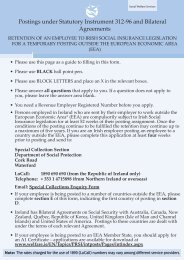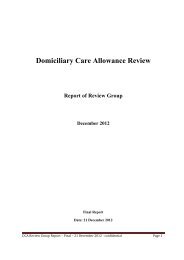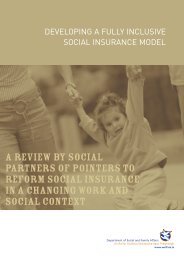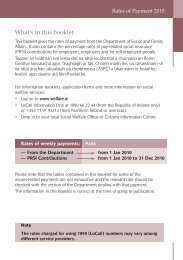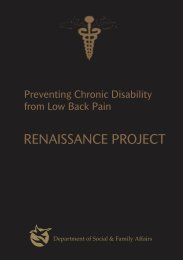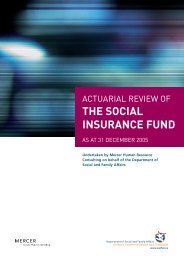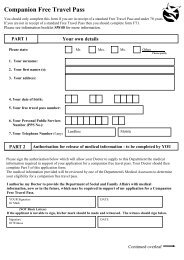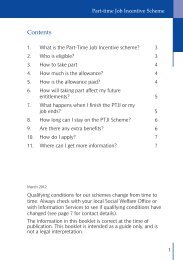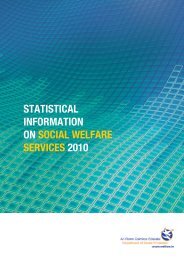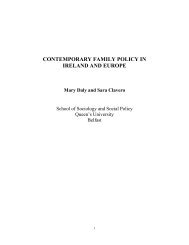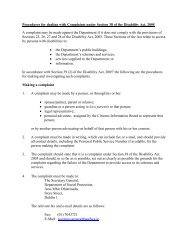department of social and family affairs annual report 2006 - Welfare.ie
department of social and family affairs annual report 2006 - Welfare.ie
department of social and family affairs annual report 2006 - Welfare.ie
Create successful ePaper yourself
Turn your PDF publications into a flip-book with our unique Google optimized e-Paper software.
goal 5: poverty, <strong>social</strong> inclusion <strong>and</strong> famil<strong>ie</strong>s<br />
• North/South Co-operation on <strong>social</strong> inclusion.<br />
Creating a more inclusive soc<strong>ie</strong>ty by alleviating<br />
<strong>social</strong> exclusion, poverty <strong>and</strong> deprivation is a<br />
continuing challenge for administrations North<br />
<strong>and</strong> South. The Irish <strong>and</strong> UK National Reports<br />
on Strateg<strong>ie</strong>s for Social Protection <strong>and</strong> Social<br />
Inclusion, <strong>2006</strong>-2008, contain common text<br />
outlining how the UK <strong>and</strong> Irish Governments<br />
are committed to developing <strong>and</strong> promoting cooperation<br />
in relation to combating poverty <strong>and</strong><br />
<strong>social</strong> exclusion. The common text also appears<br />
in Northern Irel<strong>and</strong>’s Lifetime Opportunit<strong>ie</strong>s:<br />
Government’s Anti-Poverty <strong>and</strong> Social Inclusion<br />
Strategy for Northern Irel<strong>and</strong> <strong>and</strong> feature<br />
in Irel<strong>and</strong>’s National Action Plan for Social<br />
Inclusion 2007-2016.<br />
> OBJECTIVE 2<br />
Ensure that there is a clear knowledge <strong>and</strong><br />
underst<strong>and</strong>ing <strong>of</strong> the nature, extent <strong>and</strong> causes <strong>of</strong><br />
poverty <strong>and</strong> <strong>social</strong> exclusion <strong>and</strong> the strateg<strong>ie</strong>s to<br />
address it.<br />
> OSI Data Strategy<br />
The Office for Social Inclusion (OSI) is responsible<br />
for developing a data strategy, designed to<br />
ensure that data is available in a timely manner<br />
for monitoring, evaluation, policy prioritising,<br />
targeting <strong>and</strong> overall <strong>social</strong> inclusion policy<br />
development. OSI is supported in this role by<br />
a Technical Advisory Group (TAG) comprising<br />
representatives <strong>of</strong> key Government Departments,<br />
the Central Statistics Office (CSO), the Combat<br />
Poverty Agency (CPA), the Economic <strong>and</strong> Social<br />
Research Institute (ESRI) <strong>and</strong> the Equality<br />
Authority. Membership <strong>of</strong> this group will be<br />
exp<strong>and</strong>ed to include technical experts from the<br />
<strong>social</strong> partners in line with a commitment in the<br />
national partnership agreement, Towards 2016.<br />
A rev<strong>ie</strong>w <strong>of</strong> how poverty is measured in<br />
Irel<strong>and</strong>, in order to better reflect current living<br />
st<strong>and</strong>ards was undertaken by the OSI during<br />
<strong>2006</strong>, in the context <strong>of</strong> the preparation <strong>of</strong> the<br />
new NAPinclusion. Following an ESRI study on<br />
consistent poverty measurement, the measure<br />
was changed from one based on lacking one or<br />
more items from an 8-item deprivation index to<br />
one based on lacking two or more items from<br />
an 11-item index. This revised measure has been<br />
reflected in the overall poverty goal <strong>of</strong> the new<br />
NAPinclusion, <strong>and</strong> progress in relation to this<br />
goal will be measured using the revised 11-item<br />
deprivation index. The complex issue <strong>of</strong> poverty<br />
measurement will be further considered by the<br />
OSI through the Technical Advisory Group during<br />
2007.<br />
Throughout <strong>2006</strong> OSI worked closely with<br />
government <strong>department</strong>s to seek to ensure<br />
that targets contained in the new NAPinclusion<br />
are designed to allow progress against them<br />
to be effectively monitored <strong>and</strong> measured. The<br />
importance <strong>of</strong> having relevant indicators <strong>and</strong> data<br />
sources to enable the development, monitoring<br />
<strong>and</strong> evaluation <strong>of</strong> the new Plan, <strong>and</strong> <strong>of</strong> the <strong>social</strong><br />
inclusion elements <strong>of</strong> other national strateg<strong>ie</strong>s,<br />
was addressed in discussions with relevant<br />
<strong>department</strong>s.<br />
The issue <strong>of</strong> data <strong>and</strong> information gaps was also<br />
considered in a set <strong>of</strong> <strong>social</strong> portraits developed by<br />
the ESRI for the Office for Social Inclusion during<br />
<strong>2006</strong>. The portraits provide a useful collection <strong>of</strong><br />
data in respect <strong>of</strong> persons at different stages <strong>of</strong><br />
the lifecycle <strong>and</strong> help to provide a clear picture <strong>of</strong><br />
those groups who are most at risk <strong>of</strong> poverty <strong>and</strong><br />
<strong>social</strong> exclusion. They also indicate those areas<br />
where further data is required to have a full <strong>social</strong><br />
picture <strong>of</strong> persons at each stage <strong>of</strong> the lifecycle.<br />
The first <strong>of</strong> the portraits was published in early<br />
2007.<br />
> Poverty Impact Assessment<br />
Poverty impact assessment (PIA), formerly known<br />
as poverty pro<strong>of</strong>ing, was first introduced in<br />
1998, <strong>and</strong> is the process by which government<br />
<strong>department</strong>s, local authorit<strong>ie</strong>s <strong>and</strong> state agenc<strong>ie</strong>s<br />
assess polic<strong>ie</strong>s <strong>and</strong> programmes at design,<br />
implementation <strong>and</strong> rev<strong>ie</strong>w stages in relation to<br />
the likely impact that they will have, or have had<br />
on poverty <strong>and</strong> on inequalit<strong>ie</strong>s which are likely to<br />
lead to poverty, with a v<strong>ie</strong>w to poverty reduction.<br />
OSI undertook a rev<strong>ie</strong>w <strong>of</strong> the process<br />
during 2005 <strong>and</strong> produced new, significantly<br />
54



